
During a recent trip into DC, we noticed a reporter and his cameraman just finishing an interview with a lady as we were parking the car near a street corner. They came over to the car and asked if Russ would mind chatting on camera about Congress and the payroll tax cut expiring. The reporter was Scott Thuman, Senior Political Reporter and anchor who covers the White House and Capitol Hill for Channel 7, a local ABC affiliate. They chatted for about 3-4 minutes but only a 6 word sound bite was used on air. Scott had focused the on air report on what people thought of Congress taking vacation and not staying to hammer out a deal. He used just a snippet from each of 3 interviews, so Russ’ 2 seconds of fame was “seems like they’re always on vacation”. Never know what they’ll use!

We were on our way to The United States Botanic Gardens (
http://www.usbg.gov/), the oldest continually operating botanic garden in the country. You may recall that when we visited the Gardens last year an exhibit was in the process of being put together by Applied Imagination (
http://appliedimagination.biz/) based out of KY. The miniature replicas of DC’s landmark buildings are made of natural plant materials, i.e. twigs, seeds, pods, acorn caps, grapevines

, etc. all overlaid on solid wood bases. We wanted to return this year so we could see the completed exhibit amongst the Christmas decorations of the Gardens. Every year since 2004 Applied Imagination has been creating these fabulous exhibits, which this year is entitled “Seasons Greenings”. The buildings are tucked among the plants, and it takes many painstaking hours to construct the exquisite detail of each building. In fact just the U.S. Capitol replica alone took more than 600 hours to create!
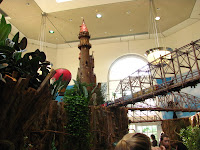
As part of the exhibit located in the East Gallery, more than 800 feet of track weaves above and through a woodsy wonderland where model trains chug along. This portion of the exhibit is called “Who Lives Here?” and includes cleverly named houses that rese
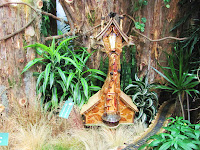
mble animals such as Giraffe Garage, Monkey Mansion, Porcupine Place, and at the end are a cluster of presidential homes with trains running through the “neighborhood”. Owner Paul Busse admits to being “an incurable model train enthusiast!” Just like last year, we were amazed at the workmanship and creativity displayed by the staff of Applied Imagination.



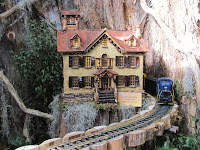

Upon entering and exiting the Garden’s Conservatory, you pass one of the largest indoor decorated Christmas trees in the DC area with several “houses” around its base. We only toured the front portion of the Conservatory, and in the West Gallery is an interactive display of how plants provide therapy,

tools, spices, and more to our everyday lives. Metal flowers contain spices or fragrant seeds so you can smell the differences and a tag will explain its purpose and/or use. There area a number of educational hands-on activities for kids (or adults) in this area.

Just across the street is the Capitol building which we passed as we walked back to our car and got to see the Capitol Christmas Tree. Not be confused with the National Christmas Tree, this one is lit by the Speaker of the House a few days later. (I hope to get a night time picture of it soon.) From there we wandered through the first floor of the National Museum of the American Indian (
http://www.nmai.si.edu/), another one of the Smithsonian museums. We had toured the
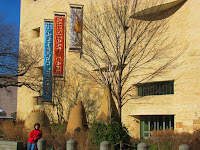
entire facility last year and just decided on a quick visit this time. However, last year we had not ventured to the other side of the building outside and missed an exhibit called
Always Becoming. It consists of five teepee sculptures that were hand-built by Nora Naranjo-Morse, the first Native American woman to create an outdoor sculpture in Washington, DC. They are made of organic materials and will gradually erode and change over time thus its name.

It was time to head across the river to Arlington National Cemetery (
www.arlingtoncemetery.mil/) starting first at the Visitor Center for a map and to view several of the many exhibits. The Cemetery’s 624 acres contain the remains of over 320,000 servicemen and women from every war and major

conflict in U.S. history. We’ve visited Arlington before but never at this time of year. Each December green wreaths with red bows are laid at a number of the headstones and it’s quite a spectacular site. It's quite sobering to see the rows and rows of white headstones that go on for miles. Since 1992 the Worcester Wreath Co. (
http://www.worcesterwreath.com/
) has donated wreaths every year to honor our nation’s fallen heroes starting with about 5,000 the first year. This year nearly 90,000 wreaths were laid by about 15,000 volunteers in roughly an hour. In 2006 Mr. Worcester expanded the project into Wreaths Across America (
www.wreathsacrossamerica.org/), a non-profit

organization whose mission is to “Remember, Honor, Teach” and coordinates the wreath laying ceremonies not only at Arlington on the 2nd Sat. in Dec. but also at veterans’ cemeteries and other locations in all 50 states. In 2010 Wreaths Across America and their volunteers laid over 220,000 memorial wreaths at 545 locations in the United States and beyond.

After visiting the graves of the President Kennedy and Jacqueline Kennedy Onasis, we made our way over to the Memorial Amphitheater where we would be able to view the Changing of the Guard at The Tomb of the Unknowns

(also known as the Tomb of the Unknown Soldier). It is guarded 24 hours a day, 365 days a year, no matter the weather. Sentinels, all volunteers, are considered to be the best of the elite 3rd U.S. Infantry Regiment headquartered in VA. Each sentinel m
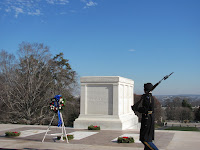
ust go through an extensive process to qualify for this honor; it’s not given to just anyone who volunteers. You can read about it on the website under Exploring the Cemetery and then click Changing of the Guard. Guards are changed every hour on the hour (and on the half during the summer), and each sentinel paces 21 steps alongside the tomb, pauses 21 seconds, and then returns 21 steps back to the other side, pauses 21 seconds, and repeats this ritual many times over the

next hour.


Across the street from the Amphitheater are memorials to the
Challenger and
Columbia shuttle crews, the soldiers killed during the 1980 Iran rescue mission, the Battle of the Bulge, and several others with many more memorials scattered throughout the cemetery. In the distance of the picture below right you can see the mast of the
USS Maine that was relocated to Arlington in 1915 to honor the 260 men who were killed when the ship was sunk in 1898.

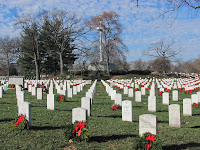

As we headed back to the car, we heard a rhythmic drum beat in the distance and seemed to be coming from up over the hill. We could see the tops of flags waving and made our way for a better view. Coming down the road was a military band followed by rifled soldiers, an honor guard, and lastly soldiers on horseback in front of a horse-drawn carriage carrying a flag draped

coffin. We watched as this funeral procession made its way along the route and the band played solemn marches. We had planned to make our way over to the memorial honoring those killed at the Pentagon on 9/11 and it just so happened that the burial was t

aking place not far from there. We pulled over and got out of the car to pay our respects as we watched the casket lowered from the buckboard and carried to the burial site where the family awaited. We felt honored to have been able to witness even a small portion of this solemn occasion. Out of respect we did not linger and went on our

way finding the 9/11 memorial which we discovered is located within view of the Pentagon. Each visit to Arlington National Cemetery is a reminder of the sacrifices so many have made for our country and evokes a sense of pride, inspiration, and a humbleness that is hard to explain.

Back in DC there was one more place we wanted to visit this day, the Martin Luther King, Jr. Memorial (
www.nps.gov/mlkm), America's 395th national park and DC’s most recent memorial. At the entry are two granite boulders that are split in half by a walkway that takes you into the open plaza where stands a 30-foot high solitary “Stone of Hope” into which Dr. King’s likeness has been carved facing towards the Tidal Basin. On o
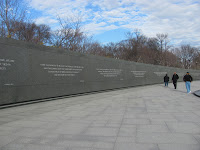
ne side of this granite boulder is a line from Dr. King’s “I Have A Dream” speech, "Out of a mountain of despair, a stone of hope”, and the split boulders represent the “Mountain of Despair” with the “Stone of Hope” having been pushed forth. Surrounding the plaza is a 450-foot crescent shaped granite wall into which 14 of Dr. King’s famous quotes are engraved. It’s an impressive memorial and tribute to a man of vision, hope, peace, and faith.

1 comment:
so neat! i've always wanted to go there, so much history !
Post a Comment